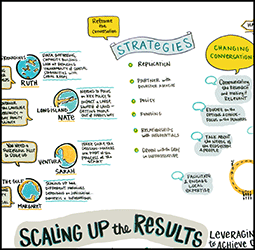Featuring work at global, regional and local scales related to the Conservancy’s Coastal Resilience program and Climate and Disaster Risk Reduction Global Priority. Topics include: integrating engineering into restoration projects, innovative partnerships with new sectors, and the Coastal Resilience approach, tools and resources for risk reduction.
CDRR 1: New Partnerships, New Approaches to Achieving Climate, Risk and Resilience Success
Presenters: Sarah Murdock, Olivia Millard, Jeff DeQuattro, Fernando Secaira, Chris Bergh
Description: CDRR offers exciting opportunities to work with new partners (e.g. Red Cross, Engineering sector, local public officials) at multiple scales (local to global). This session will discuss examples of successful partnerships, potential challenges, and lessons learned to support CDRR. Participants will gain an understanding of how to leverage the CDRR approach by working with partners, examples of what those partners offer, and how we work together most effectively.
Resources:
Chris Bergh: Southeast Florida Regional Climate Change Compact and its Coastal Resilience Working Group Presentation |
Presentation
Fernando Secaira: Mesoamerican Coastal Resilience Network Presentation |
Presentation
CDRR 2: Engi-cology or Eco-neering: The Marrying of Engineering and Ecological Principals in Coastal Areas to Reduce Risk and Increase Resiliency
Presenters: Jeff DeQuattro, Kacky Andrews, Mike Beck, Zack Ferdana, Fernando Secaira, Jeff DeQuattro, Borja Reguero, Laura Flessner
Description: This session will examine planning and restoration efforts and how large-scale restoration projects and programs are engaging national and international engineering firms to help. It will provide context to participants on the science and engineering of coastal defenses, what we do and don’t know. Participants will also receive guidance on sources of information that help make the case to decision makers for nature-based approaches and eco-engineering options.
Resources:
Borja Ruguero and Mike Beck: Assessing Coastal Risks Presentation |
Presentation
Fernando Secaira: Engineering and Ecology Presentation |
Presentation
CDRR 3: Scaling Up the Results: Leveraging Local Work to Achieve Greater Results 
Presenters: Sarah Murdock and Montserrat Acosta-Morel, Ruth Blyther, Sarah Newkirk, Nate Woiwode and Margaret Davidson
Description: Powerful successes with CDRR have been achieved at local levels. Achieving CDRR success involves working from the
bottom up to leverage the successes of our work in places while also working from the top down to achieve policy changes that help facilitate work on the ground. What examples exist of a good connection between of where this bottom-up and top-down work? And how, given limited resources, can this work be taken to scale to leverage these successes, taking advantage of policy to change the enabling environment for CDRR at national and global levels?
CDRR Tools Session A: CDRR Tool Trip: Where Can You Go, How Do You Get There, Making the Trip Worthwhile
Presenters: Lizzie McLeod , Christine Shepard, Vera Agostini, Daniel Urena Cot, Supin Wongbusarakum, Jorge Brenner, Gwynn Crichton, Nicole Love
Description: This session will focused on methods for quantifying risk/vulnerability and support development of adaptation and risk reduction strategies. We began by discussing CDRR objectives, key data, and high- and low-tech CDRR tools. We explored strategies for ensuring outputs from vulnerability assessments can be used to inform management and development plans and policies. Participants discussed challenges to selecting and implementing CDRR tools.
CDRR Tools Session B – Interactive Guided Tool Tours
Presenters: Lizzie McLeod and Chris Shepard
Description: This session provided participants with the opportunity to dig deeper into CDRR tools (e.g., Red Cross VCA; VA-LEAP; Coastal Resilience; CRiSTAL, InVest). This session will began with a very brief overview of the tools and participants were walked through live demos of the tools based on case studies solicited from participants, and examples will be shared of other applications around the globe. Data needs, challenges and lessons learned were discussed in the application of these tools, and guidance was shared regarding how to identify the most appropriate tool for a given application.
Resources:
Tools:
VA-LEAP
CDRR6: Evaluating the Effectiveness of Adaptation Measures: Does your Thinking Align with That of Your Donor?
Presenters: Imen Meliane, Kirsten Evans, Gwynn Crichton, Chris Shepard, and Kimberly John
Description: A key step in CDRR projects is measuring effectiveness. But we are not the only ones looking at the issue. Many public donors are developing monitoring and evaluation (M&E) frameworks to assess whether adaptation and disaster risk reduction measures have achieved their desired results and whether resources have been used efficiently and effectively. These types of frameworks and their related indicators will increasingly be used to evaluate project proposals in the future. This session outlined the major trends in the donor community vis a vis evaluating adaptation effectiveness, and compared that to existing approaches we are using measuring the effectiveness of our CDRR work. Participants discussed priority areas we need to focus on, and the potential implications for the design of future projects.